“A product like ACE is definitely going to be part of a sales future, be it any industry”
Gaurav Jha – Senior Manager, Strategy and Programs, Unacademy
In 2013, LeadSquared began its journey with one goal in mind: Improve Sales Efficiency. Since then, we have built sales solutions for multiple industries and use-cases and helped more than 2000 companies achieve higher sales productivity.
ACE: The Sales Performance Management Suite is the latest addition to LeadSquared’s product repertoiré. It is our attempt to cater to the last mile – the individuals, the teams who run the show.
Before we walk you through ACE—a product built to help you achieve more, let’s quickly look at the various aspects of sales performance management.
What is Sales Performance Management?
Sales is generally associated with hardcore numbers—leads, targets, expense ratios, conversions, and, of course, revenue. However, within all this jargon, we tend to forget the most important pillar of a sales program—The individuals behind the numbers.
Sales Performance Management or SPM is the art and science of getting the most out of your salespeople. It involves a range of interdependent processes to increase employee productivity, effectiveness, and performance.
The components of sales performance management include:
- Identifying and defining metrics
- Setting goals and objectives
- Tracking performance
- Field planning
- Incentives and payouts
Let’s look at these aspects in detail.
The components of a sales performance management tool
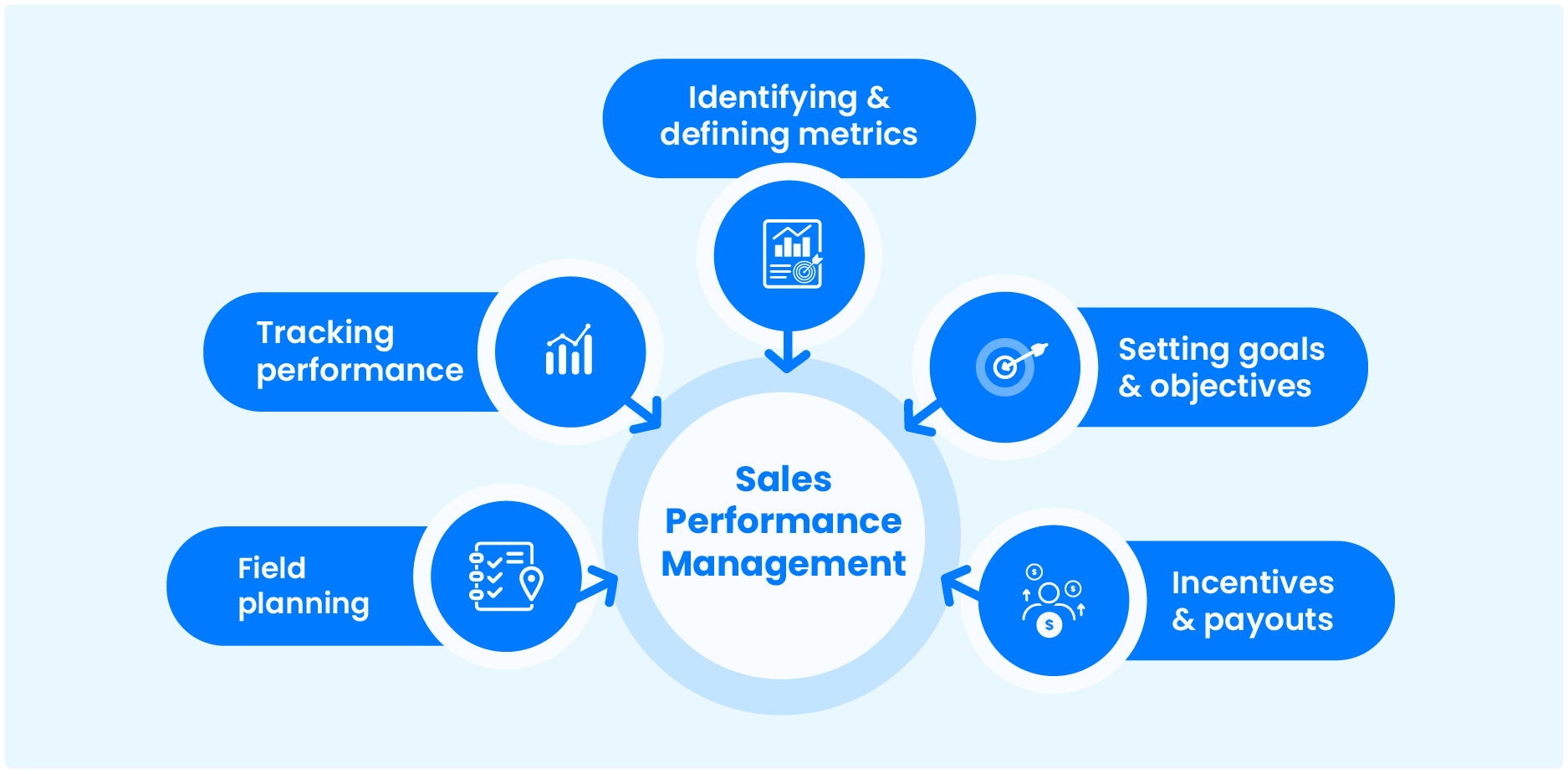
1. Identifying and defining metrics
Sales KPIs (Key Performance Indicators) or metrics are the data points that help sales teams measure their effectiveness. They can be defined for individuals, teams, and organizations. Tracking sales metrics helps managers in strategic and financial decision-making.
Note, sales performance metrics should be measurable and relevant to your business.
For example, in a tele-calling setup, your input metrics could include dialed calls, connected calls, phone call duration, and the number of counseling sessions. Subsequently, output metrics can be conversion rates, sales cycle length, and average profit margin.
Similarly, you can track the following sales performance metrics that could impact your business.
Revenue target:
- Leads converted to customers
- Total sales value
- Conversion percentage
Calling target:
- Number of dialed calls
- Number of connected calls
- Phone call duration
- Completed follow-up tasks
- Number of new leads
- Number of touched leads
- Number of untouched leads
- Number of disqualified leads
Demo targets:
- Total demos scheduled
- Number of completed demos
2. Setting goals and objectives
Once you’ve identified what metrics to measure, the next step is to establish sales goals. i.e., how much to achieve within what time frame. For example, close 5000$ in new sales by the end of Q4. Goals are usually broad. They help teams see the bigger picture and stay motivated.
Often used interchangeably with goals, objectives underline the specific, measurable actions employees can take to achieve their goals.
We asked 100 sales leaders about their goals for 2022. We found that increasing revenue (28%) and improving sales efficiency (29%) are the main focus areas for the majority of them.
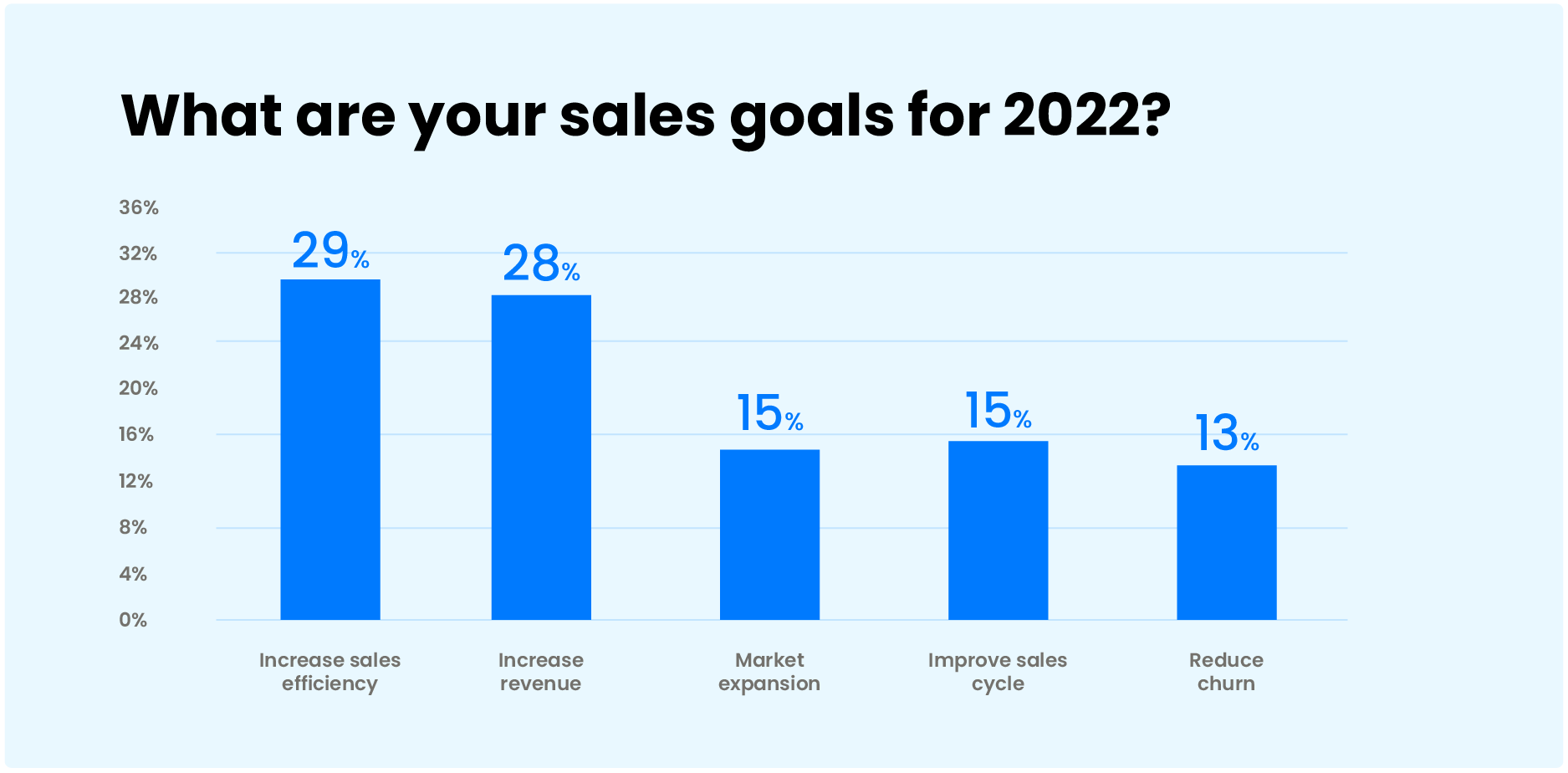
3. Tracking Performance
Monitoring and reviewing employee performance is a critical part of sales performance management. Performance reports can help identify trends and areas for improvement. It also helps managers reward top performers, forecast revenue and gauge the effectiveness of their sales strategy.
4. Field Planning
This part of sales performance management includes operational functions like territory creation, balancing, and assignment. Field planning ensures every part of the total addressable market has equitable sales coverage.
5. Incentives and Payouts
A sales incentive plan (SIP) is a business tool used to motivate and compensate a sales professional to meet goals or metrics over a specific period.
The rewards can be both monetary and non-monetary and are designed to enhance performance. You can also run short-term incentives programs like SPIFFs, track conversions, and reward your team members accordingly.
Note, while curating a compensation plan, align incentives with overarching goals. It ensures salespeople target the right customers and prioritize the best deals to reach your goals.
If implemented correctly, a sales performance management program can improve the efficiency of your sales program, thereby increasing the bottom line.
However, you’ll have a tough time if you’re still relying on manual methods of tracking your team’s performance. In the next section, we’ll give you 3 good reasons to opt for sales performance management tools.
Why do you need a sales performance management tool?
When you scale, it becomes nearly impossible to track the activities and outcomes of individuals. Result—you may not recognize the exact problem that is preventing you from getting the desired results.
Sales performance management tools are built to address these challenges. Below are the reasons to opt one.
1. Automate Manual Tasks
As important a function performance management is, most sales managers still use basic spreadsheets, which entail downloading data, organizing it according to different metrics, and manually creating pivot tables to analyze performance.
While excel can work for small teams with limited functions, they become infeasible as teams get bigger and processes become complex.
Performance management software can increase efficiency manifold by automating manual processes.
For instance, LeadSquared lets you automate everyday manual tasks like lead distribution, setting up tasks and alerts, lead qualification and prioritization, and more. It also supports automated reports on weekly activities by the sales team.
Thus, managers need not spend hours manually sifting through lead records.
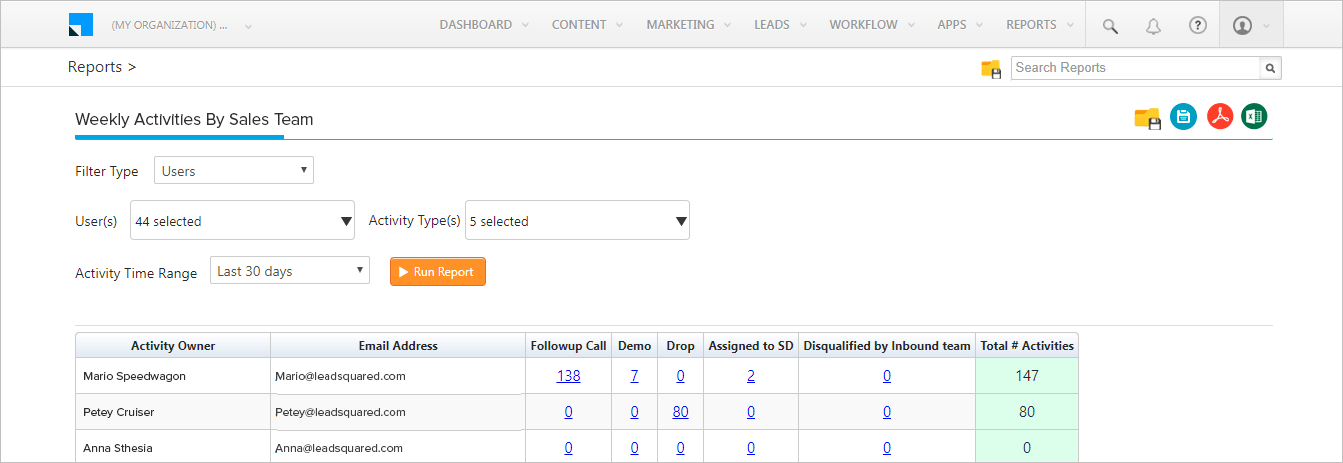
2. Make better, data-driven decisions
Data is the most important asset for any business.
A sales performance management software gives sales leaders easy access to detailed performance charts and other valuable data which support better decision making.
Data can help you with:
- Sales forecasting
- Sales pipeline management
- Calculating incentives and payouts
3. Ensure Transparency
Sales performance management is a mix of operational and analytical capabilities that connect back-office processes, like sales planning and compensation, with front-office sales functions.
Due to the number of teams and functions involved, sales leaders often have to work with multiple sources of truth. A sales performance management software can act as a single, connected platform which consolidates information and facilitates transparency for all stakeholders.
With this, we now know the importance of sales performance management tools. However, with so many options available, each with its own specifications, the next big question is—which one should you choose?
The next section answers this.
What should you look for in your sales performance management tool?
Choosing the right performance management software can help leaders improve sales efficiency by leaps and bounds. Keep these 5 factors in mind before making your decision:
1. Is it a centralized solution for all your processes?
Sales Performance Management is a web of interdependent functions. Each part of the process influences the other. Using multiple solutions for your SPM program may not be the best use of your time, and in some cases is even counterproductive.
Adopting a centralized solution allows you to track sales metrics accurately at any scale across various teams. It enables faster data consolidation and makes analysis significantly easier.
2. Does it facilitate near real-time performance tracking?
Time is of the essence in today’s hyper competitive world. Traditional performance reports are useful, but only capable of showing what has already happened. By the time you analyze, identify trends, and predict any instance of failure, it might be too late to make the right fix.
Real-time performance tracking helps leaders identify problems faster and take immediate corrective action. The following image illustrates how LeadSquared helps you track assigned vs. achieved goals in near real-time.
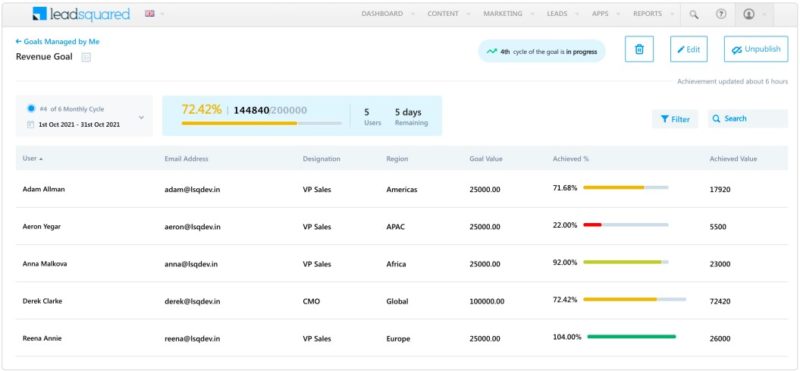
3. Is it adaptive and scalable?
As your business grows, the number of teams, processes, and employees change faster than you imagine. To prevent any lead leakage or conflicts, sales managers should be able to configure these changes with their SPM software quickly. For such situations, your software should be designed to scale, and intuitive enough that new members can use it easily.
4. Does it have gamification features?
According to Finances Online, Gamification can increase company productivity by up to 50% and employee engagement by 60%.
In Fact, most competitive SPM tools in the market today are built keeping psychological principles in mind. Features like leaderboards, nudges and achievement recognition keep employees motivated and help improve their performance.
5. How good are its insights and forecasting tools?
Does your SPM software analyze performance data and identify patterns that can potentially affect sales performance?
With sales forecasting, sales managers can share information about future sales with supply chain, finance, and the other functions of the company for better decision making. Make sure your SPM software has the capability to leverage the data points your sales teams generate daily!
Now that you know what to expect from your performance management software, checkout ACE, the freshest in the game.
LeadSquared ACE: An End-to-end Sales Performance Management Suite
While working on sales problems with our customers, our team discovered a need for an end-to-end performance management tool.
To develop a better understanding of the problem, we surveyed 100 sales leaders about the challenges they face while managing their teams.
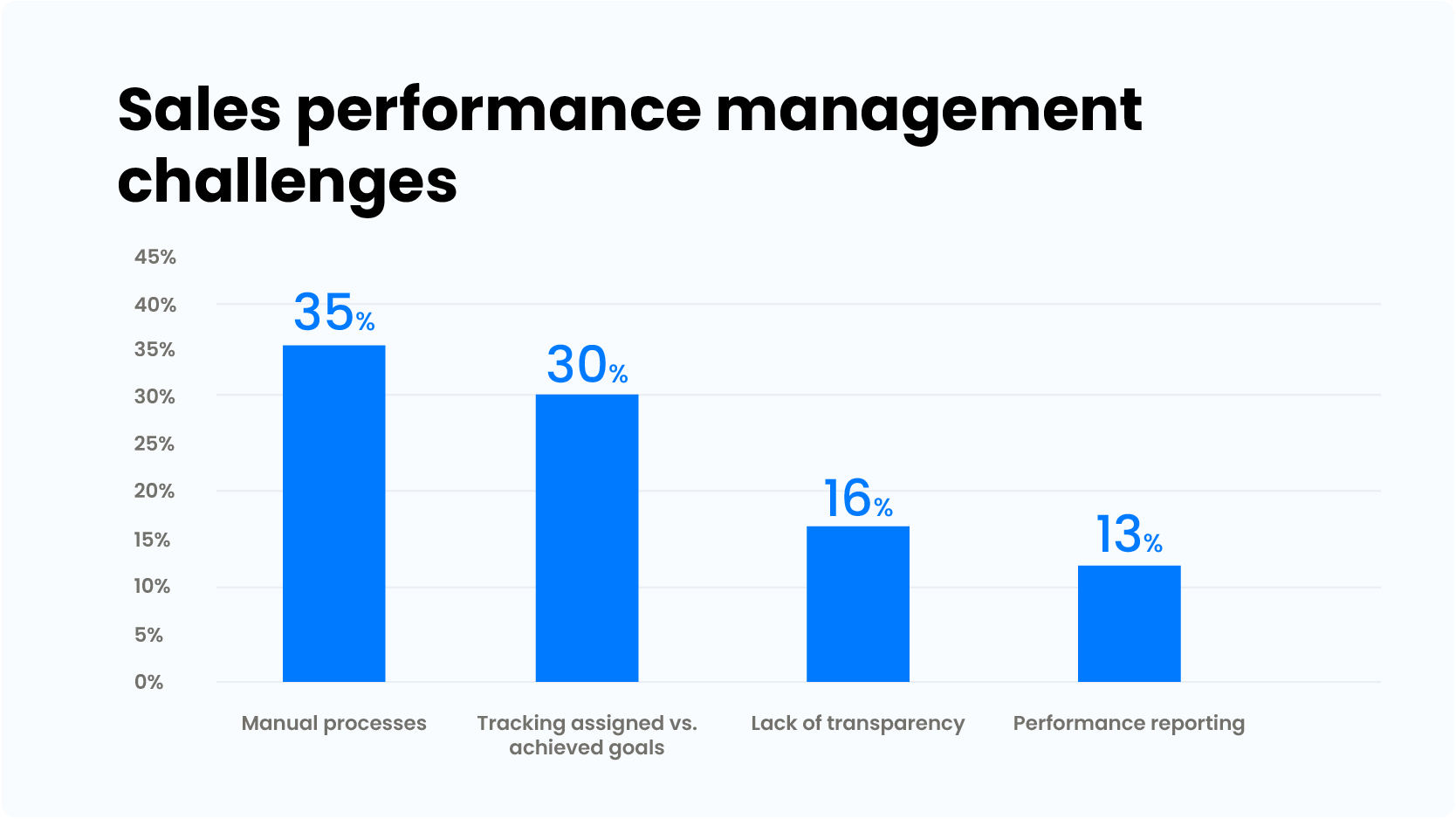
While a few performance management solutions exist in the market, very few offer a single, integrated platform to build and implement an effective SPM program. This is where ACE comes in.
The ACE Concept: Integrating CRM and Sales Performance Management
Like any competitive sales CRM, Leadsquared has all the data you’d need for tracking employee performance according to personalized metrics. Thus, instead of downloading, exporting and tracking employee performance on 2-3 different software, we decided to equip Leadsquared CRM with all the tools you need for running a comprehensive Sales Performance Management program.
With ACE, our aim is to develop a one-stop solution for sales performance management. The product suite would include Performance Analytics; Goal Setting; Gamification; Nudges and Coaching; Incentives and Payouts, and Insights and Forecasting. All of these fully integrated within our CRM software.
Product Architecture
| The Platform | Ease Of Use | Scalable |
| Ace is built on Leadsquared; hence it doesn’t need integrations with third-party tools and shows your progress real-time. | Ace is made with a user-centric approach to adapt to ever-changing business needs. | Ace is built on Big data technology to work at any scale and stage of business. |
The first and the foremost step in your sales performance management is setting up the goals and monitoring them in real time.
ACE Goals lets you do just that. You can set goals based on your key metrics, across organizational hierarchy, and track them in near real time.

With ACE, sales leaders can set clear objectives for their sales team and equip them with psychological and analytical tools that ensure accomplishments. It is a flexible, user-friendly tool capable of handling complex scenarios.
For a better understanding of Goals, you can watch this 10-min walkthrough given by Abhishek Jain, Product Manager at LeadSquared.
In this walkthrough, Abhishek will demonstrate:
- How to create goal templates using any input/output metric.
- How managers can assign both sales and revenue goals to their teams
- What every stakeholder’s dashboard looks like, how managers can monitor progress and how employees can stay motivated to accomplish their goals.
If you’d like to understand how it can work for your company, you can book a personalized demo.
How does ACE SPM tool benefit businesses? [User Reviews!]
We’ve beta-tested the concept with over 20 sales-led organizations and improved the offering based on their feedback.
Here’s what our customers feel about the product.
Improved Efficiency
ACE eliminates the need to manually assign objectives and track progress in Excel sheets.
Users can configure these with simple IF, OR, and AND logic.
Review:
“ACE Goals is a time saving experience. Earlier I used to download data, make pivot tables, and run reports for an hour, now I can do it all in 5 minutes.”
Kartik Thakur, Business Development Manager, upGrad
Increased Employee Productivity
Leadsquared ACE is built keeping psychological principles in mind. The achievement dashboard, nudges and leaderboards keep employees motivated and increase their productivity.
Review:
“Leadsquared’s Goals is a fantastic solution that has assisted us in increasing sales efficiency in terms of active funnel moment, traceability, and overall agent productivity!” This was a much-needed feature to assure our sales staffs’ seamless operation and keep them motivated.”
Sourabh P Upadhyaya, AVP – Business Development, Multibhashi
Tracking input and output metrics simplified.
Ace Goals enables managers to easily define and track various input and output metrics. One can create templates for different use cases, be it revenue targets, calling targets, lead funnels or demo targets.
Review:
“In our sales pipeline, input and output metrics are highly correlated. With ACE, we were easily able to see dig out past data in order to gauge where the employee didn’t perform well, and subsequently take corrective action.”
Sooraj Somasekhar, Sales Program Manager, Twin Health
From our survey, 65% sales leaders believe ACE Goals can impact user efficiency by 30% or more.
If you’d like to understand how ACE goals can enhance your sales efficiency, get in touch with our team.








![[Webinar] Maximizing ROI with WhatsApp CRM](https://www.leadsquared.com/wp-content/uploads/2024/07/Maximizing-ROI-with-WhatsApp-CRM-webinar-popup.gif)
